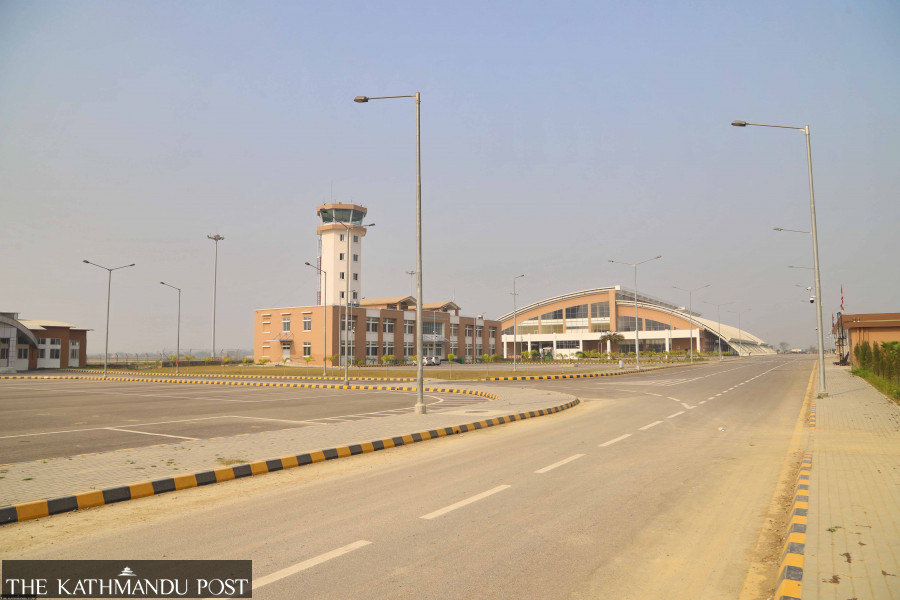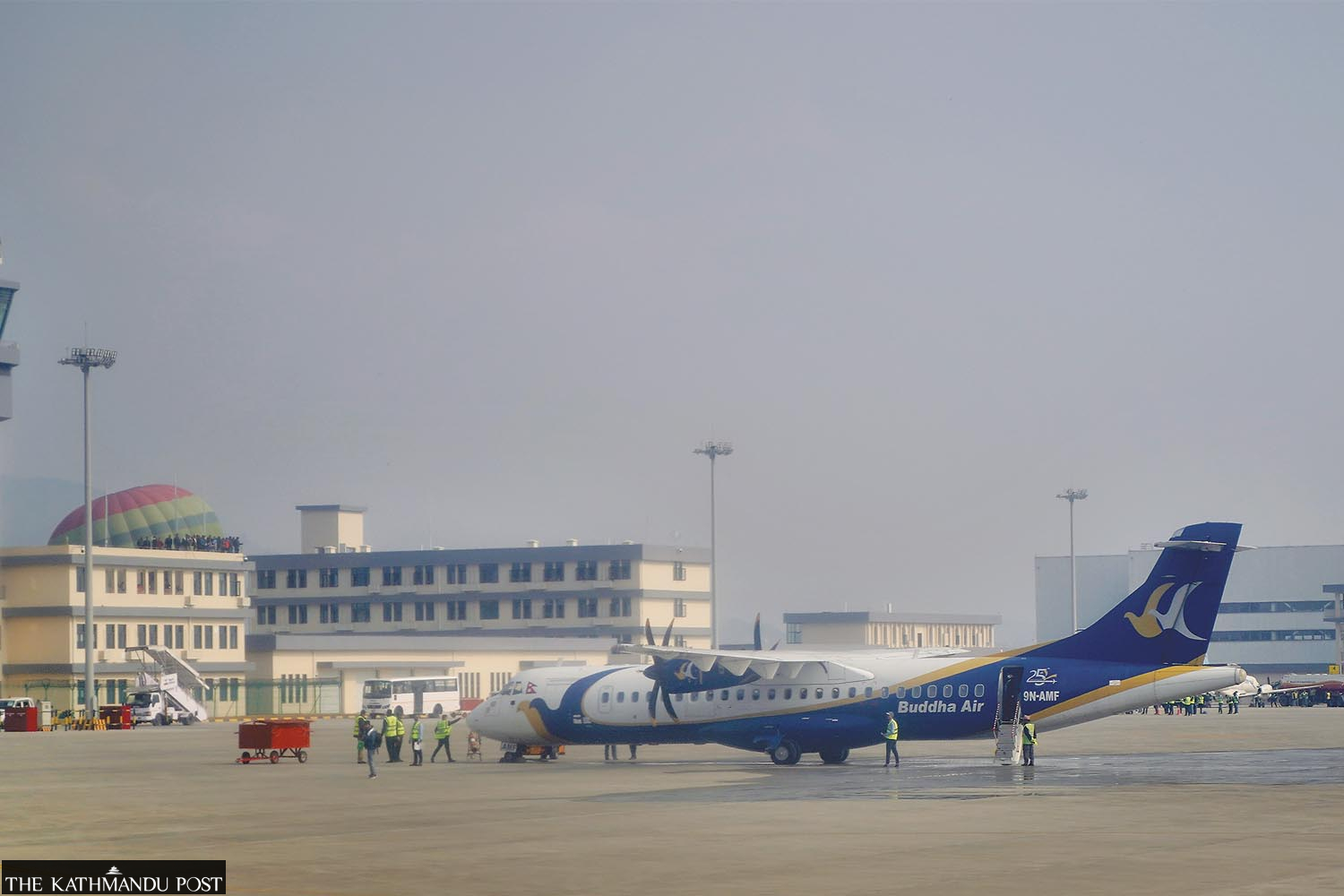Money
Nepal pins hopes on PM’s visit as airports languish
Those in Bhairahawa and Pokhara are said to be unfeasible without entry routes from the west.
Sangam Prasain
Cross-border air routes are once again in the spotlight as Nepal seeks extra entry points from India to give life to its newly completed empty airports.
But experts say the possibility of the southern neighbour cooperating is slim with ties at a low ebb, and this is what Prime Minister Pushpa Kamal Dahal will try to set right during his southern sojourn starting Wednesday.
Tourism Ministry officials say new air entry points are one of the key items on the agenda during his four-day visit to New Delhi. The prime minister appears to be optimistic that things will work out, they say.
Nepal had formally requested India to allow air access through Janakpur, Bhairahawa, Nepalgunj and Mahendranagar during Prime Minister Narendra Modi’s visit to Kathmandu in 2014.
These air routes will facilitate the movement of international flights, particularly those coming from western Nepal, to the two new international airports in Bhairahawa and Pokhara.
“The issue is being discussed at higher levels this time,” said Buddhi Sagar Lamichhane, joint secretary at the Tourism Ministry.
On May 24, a seven-member technical team led by Lamichhane met Indian officials and held talks about the possibility of getting the new entry points.
“Discussions are ongoing. We are hopeful,” said Lamichhane. “We have requested India to make the L626 route, which passes over Kathmandu-Mahendranagar-Delhi, bi-directional.”
The last time Nepal opened a new air route was on November 19, 2009 when the L626 passing over Dhangadhi was launched. The Indian government approved the L626 route as per the air service agreement signed between the two countries in September of the same year. But it is only for foreign carriers leaving Nepal.
According to Lamichhane, Indian officials have informed them that they will get back to them after discussions with the Indian Air Force. “They have cited a need to do a safety assessment of the route.”
Nepal has been prodding India for additional entry routes since 2009. The airspace agenda was endorsed during Prime Minister Modi’s visit to Nepal in August 2014.
A joint communiqué issued by the two countries at the end of the visit said: “The cross-border direct routes will facilitate flights between regional airports in Pokhara and Bhairahawa, and this will save time and money for air travellers and also improve air connectivity between India and Nepal.”
Subsequently, the prime ministers of the two countries directed their concerned authorities to meet in the next six months to resolve the issue. Based on this instruction, Nepal and India agreed to make the L626 route two-way in 2016.
In February 2017, the two countries decided to form a joint technical team and initiate discussions on the opening of three air routes.

At that time, the Indian side expressed reservations over the opening of the airspace over Bhairahawa and Nepalgunj due to the presence of its defence base in Gorakhpur. The base is spread over a large area where fighter jet exercises are conducted regularly.
However, they had hinted at the possibility of opening sections of the airspace over Nepalgunj.
Nepal has been pushing the agenda of expanding cross-border air routes as there is only a single entry point in Simara for most aircraft flying into the country.
In contrast, there are seven exit points—Bhairahawa and Mahendranagar in the west and Simara, Biratnagar, Tumlingtar, Kakkarbhitta and Janakpur in the east—for aircraft flying out of Nepal.
Two other entry points over Mechi and Tumlingtar (NONIM, to the east of Everest) have been designated for planes coming from Bhutan and Lhasa, respectively.
But the entry point in Simara is used by the majority of aircraft flying into Nepal and is, therefore, congested most of the time.
“The air route has now become a geopolitical issue, but Nepal has been sending government officials to deal with it,” said an unnamed former director general of the Civil Aviation Authority of Nepal. “The issue should be dealt with at the political level.”
The two international airports in Bhairahawa and Pokhara on which Nepal spent Rs60 billion are said to be technically unfeasible without entry routes from the west.
For example, if a Bhairahawa-bound international flight approaching from the west is not allowed to use the airspace over Bhairahawa, Nepalgunj or Mahendranagar, it has to make a 300-km detour to Simara to enter Nepali airspace, according to Tourism Ministry documents.
This roundabout route to Gautam Buddha International Airport will raise the operating cost of airlines and make flights costlier, experts say.
International flights to Pokhara will face the same problem. Ministry documents say that Pokhara-bound international flights from western Nepal will have to cover an additional 185 km in aerial distance if the new cross-border air routes are not opened.
But not all buy the argument that the only reason why Pokhara and Bhairahawa don’t see international air traffic is because of lack of entry routes.
“Obviously, the airport is financially infeasible for aircraft coming from the west. But there is no problem for aircraft coming over the east,” said Sanjiv Gautam, former director general of the Civil Aviation Authority of Nepal.
But nearly 50 percent of the international flights serving Nepal—from Malaysia, Singapore, Thailand, South Korea, Japan, China, Bhutan and Kolkata—enter the country from the east.
“So why are the planes not coming to these new airports?” asked Gautam. “The civil aviation authority is building a narrative that these airports are not being operated as India has not given routes. That is a grossly false statement,” he said.
“If Bhairahawa airport is properly marketed, flights will come. The airport should create a business environment first.”

Some officials say that these two airports have become victims of geopolitics as Pokhara airport was built with Chinese money and Bhairahawa airport was built by a Chinese firm.
India has been withholding landing permits for Himalaya Airlines to fly to New Delhi since 2015 as it is owned by a Chinese company.
“It’s clear that there is a geopolitical issue here. India is also clear that it will not buy Nepal’s electricity if any hydro project in Nepal has a Chinese component. The airport case is similar,” said insiders.
This was evident when Indian Prime Minister Modi overflew the new international airport in Bhairahawa as it was being inaugurated and landed in Lumbini in May last year.
“The possibility of getting the route is slim if we look at all these geopolitical developments,” said another former chief of the aviation authority.
Another official at the Tourism Ministry told the Post that India refused to give operating authorisation to Buddha Air to fly to Lucknow from Pokhara saying it was a “diplomatic issue”.
Buddha Air has access to Indian airports from Kathmandu’s Tribhuvan International Airport.
Until April 2018, India was positive about opening air access from the west after a technical team was formed to sort out safety issues.
“Then it abruptly became unforthcoming,” said one former air route expert from the civil aviation body.
Nepal’s relations with India soured after Nepal abruptly refused to be an observer at a joint military exercise of the Bay of Bengal Initiative for Multi-Sectoral Technical and Economic Cooperation countries in Pune in September 2018 after having made a commitment to participate.
At that time, India had expressed displeasure at Nepal’s withdrawal. The Indian defence establishment was especially angry.
Nepal then participated in the second Nepal-China joint military exercise called Sagarmatha Friendship-2 held in China's Sichuan Province the same year.
Things, including air route development, were complicated further.
“Since then, the safety assessment of the route stopped,” said the route expert.
After that, another controversy followed. India had asked Nepal if in-flight security officers—known as air marshals—travelling on Indian airlines could stay overnight in Kathmandu if there was a need. The demand stirred “unnecessary” controversy, with parliamentarians expressing suspicion over India’s intent.
Nepali officials say that after five years, they are hopeful that India won’t disappoint Nepal.




 7.12°C Kathmandu
7.12°C Kathmandu














